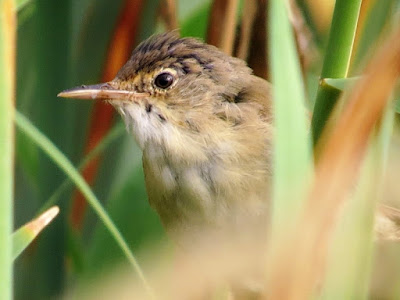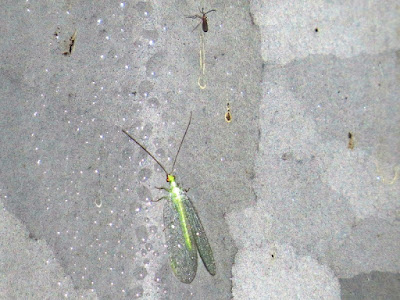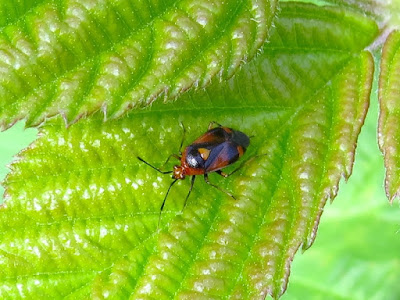12.0°C > 17.0°C: Persistent area of mainly thin medium-level cloud over and to the E, slow to thin. Light and variable wind. Good visibility.
Sunrise: 05:33 BST
* = a photo today
Priorslee Lake: 04:25 – 05:55 // 06:55 – 09:50
(165th visit of the year)
Bird notes:
- At least three of the Mallard were not eclipse drakes and were together. Possibly the duck with her two now full-grown off-spring?
- Low number of Black-headed Gulls. When I visited the football field where the early arrivals usually congregate to feed there were also three (near) adult Lesser Black-backed Gulls. The Black-headed Gulls usually more or less ignore me but the Lessers took off and the few Black-headed Gulls that had arrived went with them, never to return.
- One of the Lesser Black-backed Gulls that was later on one of the landing piers was an all-grey juvenile. Not sure I have seen such a young juvenile before.
- For the first time since March there were no Reed Buntings singing at dawn (or later). It was left to four Song Thrushes to start the new day.
Overhead:
- >73 Canada Geese: 73 outbound in seven groups; many more heard
- 2 Greylag Geese: 2 outbound together
- 19 Racing Pigeons: groups of eight and 11
- 5 Stock Doves: single and two duos
- 114 Wood Pigeons
- 5 Lesser Black-backed Gulls
- 2 Cormorants
- 1 Jackdaw
- 4 Rooks
Hirundines etc., noted:
- 2 Swifts
- 2 Barn Swallows
- 10 House Martins
Warblers noted:
- 11 Chiffchaffs
- *2 Sedge Warblers
- *6 Reed Warblers
- 3 Blackcaps
Count from the lake area:
- 2 + 4 (1 brood) Mute Swans
- 13 (10?♂) Mallard
- 3 + 3 (3 broods) Moorhen
- 48 Coots: adults and immatures
- *6 + 3 (2 broods) Great Crested Grebes
- 17 Black-headed Gulls: no juveniles
- 5 Lesser Black-backed Gulls: four (near) adults; 1 juvenile
- 3 Cormorants: arrived separately
- 2 Grey Herons: one arrived and departed
On / around the street lamps pre-dawn:
Moths:
- 1 White Plume (Pterophorus pentadactyla)
- 2 possible Hemp-agrimony Plume (Adaina microdactyla)
- 1 Common Grass-veneer (Agriphila tristella)
- 1 Small Fan-footed Wave (Idaea biselata)
- 1 Single-dotted Wave (Idaea dimidiata)
and
- 1 Common Wasp (Paravespula vulgaris)
- *2 Green lacewings (Chrysoperia sp.?)
- 2 Bridge Orb-web Spiders (Larinioides sclopetarius) again
- *3 Leiobunum rotundum/blackwalli harvestmen again; probably all L. rotundum/
In the sailing club shelter pre-dawn:
- 1 Common Wasp (Paravespula vulgaris)
- *2 Green lacewings (Chrysoperia sp.?)
- 2 Bridge Orb-web Spiders (Larinioides sclopetarius) again
- *3 Leiobunum rotundum/blackwalli harvestmen again; probably all L. rotundum/
In the sailing club shelter pre-dawn:
Spiders:
- >3 Bridge Orb-web Spiders (Larinioides sclopetarius)
Other things seen later:
Butterflies:
- Large White (Pieris brassicae)
- Small White (Pieris rapae)
- Meadow Brown (Maniola jurtina)
- *Gatekeeper (Pyronia tithonus)
- *Common Blue (Polyommatus icarus)
- >3 Bridge Orb-web Spiders (Larinioides sclopetarius)
Other things seen later:
Butterflies:
- Large White (Pieris brassicae)
- Small White (Pieris rapae)
- Meadow Brown (Maniola jurtina)
- *Gatekeeper (Pyronia tithonus)
- *Common Blue (Polyommatus icarus)
Moths:
- *Common Roller (Ancylis badiana)
- Shaded Broad-bar (Scotopteryx chenopodiata)
- *Common Footman (Eilema lurideola)
- *Common Roller (Ancylis badiana)
- Shaded Broad-bar (Scotopteryx chenopodiata)
- *Common Footman (Eilema lurideola)
Bees / Wasps etc.:
- Honey Bee (Apis mellifera)
- Garden Bumblebee (Bombus hortorum)
- *Tree Bumblebee (Bombus hypnorum)
- *Red-tailed Bumblebee (Bombus lapidarius)
- Common Carder Bee (Bombus pascuorum)
- *Buff-tailed Bumblebee (Bombus terrestris)
- Common Wasp (Paravespula vulgaris)
- Honey Bee (Apis mellifera)
- Garden Bumblebee (Bombus hortorum)
- *Tree Bumblebee (Bombus hypnorum)
- *Red-tailed Bumblebee (Bombus lapidarius)
- Common Carder Bee (Bombus pascuorum)
- *Buff-tailed Bumblebee (Bombus terrestris)
- Common Wasp (Paravespula vulgaris)
Hoverflies:
- Marmalade Hoverfly (Episyrphus balteatus)
- *Furry Dronefly (Eristalis intricarius)
- Tapered Dronefly (Eristalis pertinax)
- Common Dronefly (Eristalis tenax)
- Short Melanostoma (Melanostoma mellinum)
- *Chequered Hoverfly (Melanostoma scalare)
- Dead-head Hoverfly (Myathropa florea) [Batman Hoverfly]
- Syrphus sp. (S. ribesii / S. vitripennis)
- *Superb Ant-hill Hoverfly (Xanthogramma pedissequum)
- Marmalade Hoverfly (Episyrphus balteatus)
- *Furry Dronefly (Eristalis intricarius)
- Tapered Dronefly (Eristalis pertinax)
- Common Dronefly (Eristalis tenax)
- Short Melanostoma (Melanostoma mellinum)
- *Chequered Hoverfly (Melanostoma scalare)
- Dead-head Hoverfly (Myathropa florea) [Batman Hoverfly]
- Syrphus sp. (S. ribesii / S. vitripennis)
- *Superb Ant-hill Hoverfly (Xanthogramma pedissequum)
Damsel-/Dragon-flies:
- *Common Blue Damselfly (Enallagma cyathigerum)
- *Common Blue Damselfly (Enallagma cyathigerum)
Bugs:
- *bug #1: Oncotylus viridiflavus
- *bug #2: Red Bug (Deraeocoris ruber)
- Common Green Shieldbug (Palomena prasina): instar
Beetles:
- 7 Spot Ladybird (Coccinella 7-punctata)
- *bug #1: Oncotylus viridiflavus
- *bug #2: Red Bug (Deraeocoris ruber)
- Common Green Shieldbug (Palomena prasina): instar
Beetles:
- 7 Spot Ladybird (Coccinella 7-punctata)
Molluscs:
- White-lipped Snails (Cepaea hortensis) as ever
- White-lipped Snails (Cepaea hortensis) as ever
Mammals:
- 1 Pipistrelle-type bat
- 1 Noctule-type bat (briefly and only after the street lights went out at 05:15)
- 1 Pipistrelle-type bat
- 1 Noctule-type bat (briefly and only after the street lights went out at 05:15)
This Sedge Warbler was sitting up and looking around and taking no apparent notice of the dogs barking at me as I was taking its photo.
Its other side!
A sombre-looking Reed Warbler: a hint of a gape line so this is a juvenile.
And giving its churr alarm call – it probably felt I was too close!
A Large White – note the inner edge of the black around the wing tip is curved (almost straight on Small White); and the black extends along way down the trailing edge. This is a female with a black spot in both pairs of wings.
Yesterday it was a Meadow Brown showing signs of wear. Today a Gatekeeper (Pyronia tithonus). Amazingly it did not fly in circles! The brown shading across the forewing indicates that this is a male.
Good to get a Common Blue (Polyommatus icarus) this way up – and a male at that. Females' upper wings are variably but mainly brown.
I usually see this micro-moth many feet up a lamp pole in the dark and rarely get as good a view as this. It is a Common Roller (Ancylis badiana)
Almost certainly a Common Footman moth (Eilema lurideola). There are several similar species with slightly different shades of silvery grey wings and it can be difficult to judge from photos. 'In the field' it looked like a Common Footman.
Not at the best angle to see whether this bumblebee has a pure white tail but I think a Tree Bumblebee (Bombus hypnorum) rather than a Common Carder Bee (Bombus pascuorum) on the basis of the white hairs visible along the flank area.
I find Red-tailed Bumblebee (Bombus lapidarius) hardest to photograph – they seem more restless than other bumblebees. The best I could manage today. On Meadow Vetchling (Lathyrus pratensis).
With a hint of buff between the black of the abdomen and a rather off-white tail this is a Buff-tailed Bumblebee (Bombus terrestris).
This Furry Dronefly (Eristalis intricarius) does not look much other Eristalis drone flies. A variable species with the furry bits being rufous or white, the latter tending to be more prevalent in late summer. My first of this year.
This is a female Chequered Hoverfly (Melanostoma scalare). Only females have the triangular shaped yellow marks; the male has a longer body with three pairs of rectangular spots.
A stunning hoverfly, always worth a photo. It is a Superb Ant-hill Hoverfly (Xanthogramma pedissequum)
A male Common Blue Damselfly (Enallagma cyathigerum). Very few around at the moment as we come to the end of their flight season.
So we had better have another.
This is one of the green lacewings. As usual there are several to choose from and identification is best achieved from the pattern of venation in the wings – not here when it is covered in dew it isn't! He has a tiny friend about which I have no idea. There were two here this morning and another on my walk to The Flash.
A new plant bug for me: an Oncotylus viridiflavus, noted as favouring Knapweed – as here.
As I was photographing bug #1 this scuttled in to view – a Red Bug (Deraeocoris ruber).
To separate females of the Leiobunum rotundum/blackwalli harvestmen complex it is not necessary to see the eye-surround. It can be done on the shape of the saddle. This is an L. rotundum; on L. blackwalli the saddle markedly widens toward the back.
I found this pellet on one arm of the 'boxing ring' along the dam. Recourse to my 'Tracks and Signs' book leads to its identification as from a Carrion Crow. Common Buzzard is similar shape but would be more compressed and contain fur, whereas that of a crow contains seeds, as clearly seen here. I do wonder about Magpie though. There is no illustration of their pellets that I can find and they are frequent users of the boxing ring.
(Ed Wilson)
Between the lake and The Flash:
On the lamps
------------------------------------------------------------------------------------------------------
Between the lake and The Flash:
On the lamps
- 1 Green lacewing (Chrysoperia sp.?)
(Ed Wilson)
------------------------------------------------------------------------------------------------------
In the Priorslee Avenue tunnel:
- *1 possible White-streak Grass-veneer (Agriphila latistria)
- *1 Riband Wave (Idaea aversata)
- 2 Small Fan-footed Wave moth (Idaea biselata)
Spiders
Not recorded
A particularly good specimen of a Riband Wave (Idaea aversata) of the form where the area between the two outer cross lines is not dark. This form seems to predominate locally.
(Ed Wilson)
(Ed Wilson)
------------------------------------------------------------------------------------------------------
The Flash: 06:00 – 06:50
(150th visit of the year)
Two excellent moths today – not unusual, just smart.
Bird notes:
- Yesterday's new brood of seven Mallard ducklings now down to six. Yet another increase in adult Mallard numbers.
- Still several Coots sitting on nests and presumably eggs.
Birds noted flying over here:
- 2 Feral Pigeons: singles
- 11 Wood Pigeons
Hirundines etc., noted:
- 2 House Martins
Warblers noted:
- 8 Chiffchaffs
- 1 Blackcap
On /around the water:
- 24 Canada Geese
- 4 Greylag Geese
- 3 + 2 (1 brood) Mute Swan
- *54 (?♂) + 6 (1 brood) Mallard
- 39 (?♂) + 4 (1 brood) Tufted Duck
- 3 + 2 (1 brood) Moorhens
- 10 juvenile Coots (6 broods)
- 1 Great Crested Grebe
- 3 Black-headed Gulls only: no juveniles
On various lamp poles:
- *1 Black Arches moth (Lymantria monacha)
- *1 Red Underwing moth (Catocala nupta)
- 1 caddis fly sp.
- 3 Dicranopalpus ramosus agg. harvestmen
Two excellent moths today – not unusual, just smart.
Bird notes:
- Yesterday's new brood of seven Mallard ducklings now down to six. Yet another increase in adult Mallard numbers.
- Still several Coots sitting on nests and presumably eggs.
Birds noted flying over here:
- 2 Feral Pigeons: singles
- 11 Wood Pigeons
Hirundines etc., noted:
- 2 House Martins
Warblers noted:
- 8 Chiffchaffs
- 1 Blackcap
On /around the water:
- 24 Canada Geese
- 4 Greylag Geese
- 3 + 2 (1 brood) Mute Swan
- *54 (?♂) + 6 (1 brood) Mallard
- 39 (?♂) + 4 (1 brood) Tufted Duck
- 3 + 2 (1 brood) Moorhens
- 10 juvenile Coots (6 broods)
- 1 Great Crested Grebe
- 3 Black-headed Gulls only: no juveniles
On various lamp poles:
- *1 Black Arches moth (Lymantria monacha)
- *1 Red Underwing moth (Catocala nupta)
- 1 caddis fly sp.
- 3 Dicranopalpus ramosus agg. harvestmen
Just six Mallard ducklings remain.
A quite splendid moth: it is a Black Arches (Lymantria monacha). I see it most years here or at the lake. Smart.
An even bigger moth: a Red Underwing (Catocala nupta). The red can really only be seen in flight though there is a small area just visible above the black border to the underwing. The wings are up to 4cm (One one and a half inches as I prefer). Occasionally known to fly in the afternoon to feed on buddleia.
(Ed Wilson)
------------------------------------------------------------------------------------------------------
On this day
2020Priorslee Lake
Today's Sightings Here
Today's Sightings Here
2019
Priorslee Lake
Today's Report Here
2017
Priorslee Lake
Today's Sightings Here
2015
Priorslee Lake
Today's Sightings Here
2013
Trench Lock Pool
4 Common Terns
(Dave Tromans)
2012
Priorslee Lake
Green Sandpiper
(Ed Wilson)
2011
Priorslee Lake
3 Common Terns
(Ed Wilson)
2008
Priorslee Lake
Black-tailed Godwit
Little Grebe
(Ed Wilson)
2008
Priorslee Lake
Black-tailed Godwit
Little Grebe
(Ed Wilson)



























